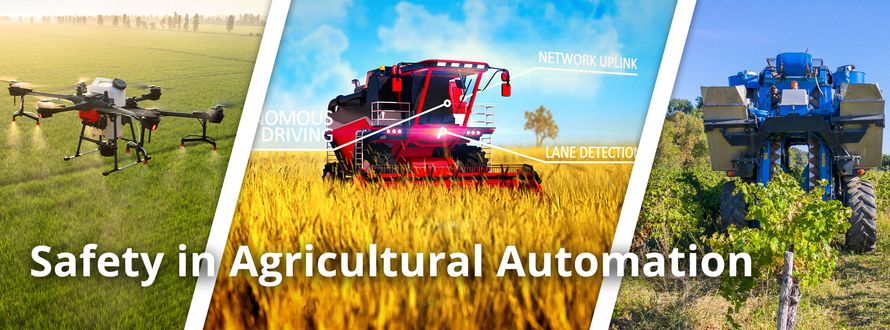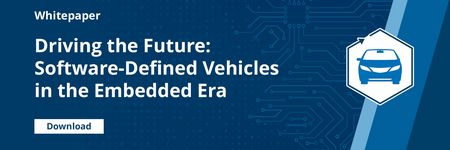
Safety in Agricultural Automation: The Role of Certifiable RTOS & Hypervisor Technology
– PikeOS, Avionics & Defense, Automotive, Energy & Environment, Industrial Automation, SafetyAgriculture is undergoing a technological transformation. Tractors, harvesters, and drones are no longer purely mechanical tools; they are evolving into smart, software-driven systems. Digitalization, automation, and connectivity are increasing productivity but also introducing new layers of system complexity.
At the heart of this transformation lies a pressing question: How can we guarantee safety in agricultural machinery when software controls critical operations?
Standards like ISO 25119 (Tractors and machinery for agriculture and forestry) adapt the general principles of IEC 61508 (Functional Safety of Electrical/Electronic/Programmable Systems) to the specific requirements of agricultural machinery. Similar to ISO 26262 for automotive, ISO 25119 defines the Agricultural Performance Level (AgPL), which helps manufacturers assess risks and determine safety requirements for electronics and software.
As more functions are consolidated on shared computing platforms—whether inside a tractor, on an implement ECU, or in an agricultural drone—certifiable real-time operating systems (RTOS) and safety-certified hypervisors become essential. These technologies enable safe consolidation of workloads, isolation of safety-critical functions, and compliance with safety standards.
Complexity and Heterogeneity in modern Agriculture
Modern agricultural machinery integrates a wide variety of subsystems:
- Engine management and drive control
- Precision agriculture tools (seeding, fertilizing, spraying)
- Autonomous navigation and steering
- Implements connected via ISOBUS (ISO 11783)
- Cloud and farm management system integration
While standards like ISOBUS allow interoperability between tractors, implements, and farm PCs, the increasing degree of networking and autonomy multiplies complexity. The challenge is not only designing reliable subsystems but ensuring that the whole system functions deterministically and safely, even as new features are added.
This is where RTOS and hypervisor technologies provide value: they allow partitioning of complex, heterogeneous systems into isolated, verifiable domains.
Safety in Land: Tractors, Implements, and mobile Automation
Example: The Job Computer (ECU)
Electronic Control Units (ECUs) for implements or self-propelled agricultural machinery act as job computers. They read sensor data, control actuators, and communicate with the tractor via ISOBUS.
To comply with ISO 25119, such ECUs must be designed with clear safety levels (AgPL b or c in many cases). For example:
- Monitoring hydraulic valves for sprayers
- Controlling seeding depth and precision
- Managing fertilizer distribution based on soil data
A certifiable RTOS ensures that these safety-critical control loops run deterministically, unaffected by less critical functions like user interfaces or cloud communication.
When combined with a safety hypervisor, multiple workloads can run on the same processor:
- A safety partition for control functions (meeting AgPL/ISO 25119 requirements)
- A general-purpose partition for operator displays or telematics (Linux, Android, etc.)
This approach reduces hardware cost and complexity while ensuring freedom from interference (FFI), a key requirement in safety standards.
Safety in Air: Drones and Aerial Agriculture
Agricultural drones present another frontier where safety intersects with automation. Use cases include:
- Crop monitoring with multispectral imaging
- Precision spraying of pesticides and fertilizers
- Automated field surveying for yield prediction
In drones, the safety-critical flight control system must always remain operational, even if high-performance payload software (e.g., image analysis or AI-based decision-making) fails.
Here, certifiable RTOS kernels run real-time flight control loops, while a hypervisor isolates AI/vision workloads. If the non-critical software crashes, the drone still maintains safe flight and can return to base.
Standards from aviation, such as DO-178C, provide a framework for airborne safety-critical systems. While ISO 25119 covers land equipment, lessons from avionics safety engineering are increasingly relevant as drones become integral to farming.
Software-Defined Vehicles (SDV) in Agriculture
The trend of software-defined vehicles (SDV), prominent in automotive, is now reaching agriculture and off-highway sectors. Instead of fixed-function ECUs, tractors and drones are evolving into flexible computing platforms where new features can be added via software updates.
Use cases:
- A tractor updates its autonomous navigation software remotely
- A drone receives an AI upgrade for better weed detection
- Implements gain smarter control algorithms through over-the-air (OTA) updates
For this to be safe, the underlying software platform must guarantee that safety-critical partitions remain unaffected by such updates. This is precisely what safety-certified hypervisors and RTOS architectures enable: a stable, certifiable core with flexible application domains around it.
Why certifiable RTOS & Hypervisors matter
The integration of certifiable RTOS and hypervisors addresses several challenges:
- Functional Safety Compliance
- ISO 25119 requires systematic processes and verification for safety-related software
- A certifiable RTOS provides artifacts, documentation, and certification kits to accelerate compliance
- Determinism & Real-Time Guarantees
- Safety-critical control loops (e.g., braking, spraying, flight stabilization) require hard real-time behavior
- General-purpose OS like Linux cannot provide strict determinism—hence the need for a safety RTOS kernel
- Workload Consolidation with Isolation
- Hypervisors allow running multiple OS instances on one hardware platform while enforcing strict isolation
- Example: A single processor can host both a Linux farm management interface and a safety-certified control loop, reducing hardware costs
- Cybersecurity Integration
- As machinery becomes connected (cloud, telematics, remote updates), attack surfaces increase
- Hypervisors can isolate network-facing functions from safety domains, improving resilience against cyber threats
Why PikeOS is an ideal Platform for agricultural Safety and Automation
When it comes to safety-certified RTOS and hypervisor technology, PikeOS from SYSGO stands out as a robust platform that addresses the specific needs of agricultural and aerial systems. It provides both functional safety and cybersecurity guarantees, making it highly suited for tractors, drones, and implements where reliable performance and certification readiness are paramount.
1. Safety-certified by Design
- Comprehensive Certification Support: PikeOS is designed with certification in mind and has been successfully certified against a wide range of safety standards, including ISO 26262 (automotive), IEC 61508 (industrial), or DO-178C (avionics)
- Certification Kits & Documentation: SYSGO provides complete certification evidence and toolchains to accelerate the compliance process, significantly reducing time and cost for OEMs
This is crucial in agriculture, where compliance for AgPL b/c must be achieved without incurring the prohibitive certification efforts typically associated with developing custom RTOS solutions.
2. Mixed-Criticality Support via Hypervisor Technology
- Partitioning: PikeOS combines a performant and robust RTOS kernel with a separation kernel hypervisor, enabling strict isolation of partitions
- Mixed Workloads: Safety-critical tasks (e.g., hydraulic valve control, drone flight stabilization) can run alongside non-critical applications (e.g., operator displays) on the same hardware—without interference
- Determinism: Real-time domains always execute deterministically, even if Linux or Android partitions are under load
For tractors or drones, this means cost-efficient consolidation: One processor can manage both real-time control and connectivity/UX functions, while still meeting AgPL safety levels.
3. Security Features for connected Agriculture
Agriculture is becoming increasingly connected, with OTA updates, fleet management, and remote diagnostics. This introduces cybersecurity challenges that must not compromise safety. PikeOS directly addresses this with:
- Common Criteria EAL 5+ Certification for its separation kernel, providing a high level of assurance for secure partitioning
- Secure Boot & Cryptographic Services to protect against tampering
- Freedom from Interference ensuring that if a networked application is compromised, the safety partition remains unaffected
This is particularly important for smart farming scenarios where machines communicate with cloud platforms or receive remote updates while still operating in the field.
4. Scalability and Flexibility
Agricultural systems vary widely in scope—from lightweight ECUs in implements to compute-heavy autonomous tractors or drones. PikeOS supports:
- Multiple hardware architectures (ARM, x86, PowerPC, and RISC-V), giving OEMs flexibility in hardware choice
- Configurable partitions for small controllers or high-performance SoCs
- Future-proof SDV compatibility, enabling over-the-air feature deployment while maintaining a certifiable safety baseline
This scalability makes PikeOS suitable for both simple AgPL b ECU controllers and complex SDV-ready platforms for autonomous farming fleets.
Proven Track Record across Industries: Why this matters for Agriculture
One might ask: If agricultural machinery is governed by ISO 25119—a norm less complex and less demanding than aerospace (DO-178C) or automotive (ISO 26262)—why should an agricultural OEM choose PikeOS, which was built to meet far stricter certification requirements?
There are several compelling reasons:
- Future-proofing against rising Requirements
Regulations in agriculture may currently allow more flexibility, but trends point to increasing safety expectations as machines become more autonomous and operate closer to public environments (e.g., autonomous tractors on public roads, drones over populated areas). Choosing PikeOS gives OEMs a platform already capable of higher certifications, ensuring that their architecture will not hit a dead end as requirements evolve. - Reuse of Certification Evidence
PikeOS comes with a rich set of certification artifacts proven in various industries. Even if ISO 25119 is less demanding, an OEM can reuse evidence, processes, and tools to accelerate compliance. This reduces both the engineering effort and the risk of non-conformity during audits. - Safety and Security by Default
While some agricultural OEMs may attempt to build on general-purpose OS like Linux, this approach usually requires costly additional effort to retrofit safety and security. PikeOS, on the other hand, has safety and security already built in from the start. For OEMs, this means fewer unknowns, shorter time-to-market, and less risk of redesign when new safety functions are added. - Operational Reliability in harsh Environments
Agricultural machines face extreme conditions (dust, temperature swings, vibrations). Hardware failures and unexpected events are common. PikeOS’s separation kernel and deterministic scheduling ensure that failures are contained and that critical functions (e.g., emergency stop, hydraulic cutoff) always take precedence—even if less important software fails. - Market Differentiation
Farmers and fleet operators are increasingly asking for reliability, connectivity, and autonomy. By adopting PikeOS, OEMs can credibly position their equipment as “built on aerospace-grade safety technology”, turning compliance into a competitive advantage rather than a burden. - Enabler for the Software-Defined Vehicles
As agricultural machinery shifts towards software-defined architectures, the need for a flexible yet certifiable platform becomes critical. PikeOS allows OEMs to introduce new functions via software updates without compromising the safety baseline, something general-purpose OS platforms cannot provide without significant modification.
In short, agricultural OEMs can take advantage of PikeOS because it reduces risk, accelerates compliance, and future-proofs their systems in a sector where safety demands are rapidly catching up with those in automotive and aerospace.
Outlook: Towards safe, autonomous Farming
The agricultural sector is moving into a phase where safety and automation are deeply intertwined. Future systems will increasingly involve:
- Tractor-Implement Management (TIM): Implements autonomously adjusting tractor speed and parameters
- Fleet-level coordination: Multiple autonomous vehicles working together, on land and in the air
- Integration with smart farming platforms: Cloud-based optimization of planting, irrigation, and harvesting
Each of these steps requires not just higher performance but stronger guarantees of safety and determinism. Certifiable RTOS and hypervisors, like PikeOS, will be central to managing complexity while satisfying ISO 25119 and related standards.
As land and aerial agricultural systems converge into an ecosystem of software-defined, safety-critical machines, the role of certifiable embedded platforms will be as crucial as the mechanical engineering innovations that once defined farming.
Conclusion
Safety in agriculture is no longer just about mechanical robustness—it is increasingly about functional safety in complex, interconnected software systems. Standards like ISO 25119 provide the framework, but the real enabler is the adoption of certifiable RTOS and hypervisor technologies, like PikeOS.
By combining deterministic real-time execution with secure workload isolation, these platforms allow tractors, implements, and drones to operate safely, efficiently, and autonomously.
In the journey toward software-defined farming, safety will remain the cornerstone—and certifiable embedded platforms will be the foundation on which the next generation of agricultural automation is built.
-
Previous
-
Next

 Twitter
Twitter LinkedIn
LinkedIn Facebook
Facebook Reddit
Reddit RSS
RSS Copy link
Copy link
